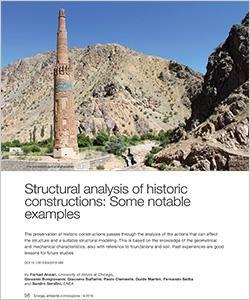
Structural analysis of historic constructions: Some notable examples
by Farhad Ansari - University of Illinois at Chicago -, Giovanni Bongiovanni, Giacomo Buffarini, Paolo Clemente, Guido Martini, Fernando Saitta, Sandro Serafini - ENEA
DOI 10.12910/EAI2016-066
The preservation of historic constructions passes through the analysis of the actions that can affect the structure and a suitable structural modeling. This is based on the knowledge of the geometrical and mechanical characteristics, also with reference to foundations and soil. Past experiences are good lessons for future studies
The preservation of architectural heritage is a delicate task, especially for structures exposed to relevant seismic risk, and requires a balance between the structural safety needs and the respect for the architectural and cultural values. Most of the historical and architectural heritage is made of ancient masonry constructions, characterized by a wide range of uncertainties and high seismic vulnerability.
The first step in the structural analysis is the evaluation of actions that can affect the construction. The correct and complete description of the seismic input for structural design at a given site is given by the acceleration components along three orthogonal axes, recorded on-site during a suitable number of real events or selected in world-wide accelerometric databases. In practical applications, when using linear analysis, the horizontal and vertical on-site response spectra can be used to determine the maximum seismic effects on structures.
The second step refers to the structural modeling, which requires a good knowledge of the geometrical and mechanical characteristics …

